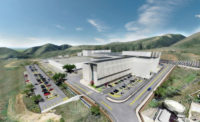 |
| Fujairah water and power project is a milestone in regional infrastructure development. (Photo courtesy of U.A.E. Offsets) Click on photo for larger image. |
The war clouds gathering at the north end of the Persian Gulf have not cast a shadow over the United Arab Emirates near the south end of that body of water. Several decades of oil production have given the kingdom an enviable living standard. A long-running construction boom in Abu Dhabi and Dubai shows no signs of abatement as a healthy mix of public- and private-sector projects steams ahead.
Dolphin Energy Gas Projects
Abu Dhabi-based Dolphin Energy Ltd. will soon issue a proposal request for an engineer-procure-construct contract on a $4-billion project that will transport "wet" gas 80 km from offshore wells to Dolphin's dedicated new processing plant at Ras Laffan, Qatar. Process "lean" natural gas will flow via a 440-km, 48-in.-dia undersea pipeline to a riser platform offshore the U.A.E. From there, gas will move through two pipeline segments to distribution points at Taweelah in Abu Dhabi and Jebel Ali in Dubai, an official says. In February 2002, Fugro Middle East was awarded the contract to plot the land area for the Qatar gas gathering plant and the undersea pipeline route to the UAE. In March 2002, Kellogg Brown & Root received the contract for front-end engineering design of the pipeline and an offshore riser platform. Upon completion in 2006, a joint venture of Dolphin Investment Co. (51%), TotalFinaElf of France and Los Angeles-based Occidental Petroleum Co. (with equal minority shares) expects to pump up to 2 billion cu ft of natural gas daily.
Late last month, Dolphin ordered more than 400,000 tonnes of high-quality steel pipe from Japan-based Mitsui & Co. Ltd. As part of its mandate from Dolphin, Mitsui will provide a detailed financing proposal for up to 100% of the value of the midstream EPC contract, including the line pipe procurement. Other Japanese financing parties are expected to participate in the financing as well, Dolphin officials say.
 |
| U.A.E. is looking for ways to manage its resources wisely. (Photo by Salim Khamis for ENR) |
Another project, for which Halliburton Brown & Root Ltd. is Dolphin's project management consultant, will receive, store and distribute the lean gas from Qatar. Under a $65-million EPC contract, since August 2002, India-based Dodsal Pte has been constructing a 182-km, 24-in.-dia gas pipeline from Al Ain to Fujairah, scheduled for completion in September 2003. This line is seen as a milestone in the development of the Gulf Cooperation Council, a loose organization promoting economic and political cooperation among the gulf states, because for the first time it will transport gas from one GCC member state to another. The Qatar-U.A.E gas project will be a second such intramural gas-transportation project.
The line to Fujairah will supply up to 135 million cfd of gas to fuel a 656-Mw electricity generation plant in that coastal city. A new 100-million-gallon-per-day desalination plant will use 120 Mw of its output. South Korea-based Doosan Heavy Industries & Construction Co. is constructing the two plants on a fast-track schedule under an $802-million contract. A partnership of U.A.E.-based Al Jaber Energy Services and Technip-Coflexip of France is working under a $453-million contract to construct a 180-km dual pipeline from the desalination plant to Sweihan, with an 18-km spur to Al Dhaid in Sharjah. And Larsen & Toubro, Mumbai, is constructing a 69-km double-circuit 400-kv transmission line to deliver 500 Mw of electric power from the generation plant to Al Dhaid. Eventually the line will interconnect with the upcoming national grid at Al Dhaid. Completion of the powerplant and desalination plant is scheduled for mid-2003.
Gas-to-Liquids
The world's largest gas-to-liquid plant is to be build in Qatar under a new turnkey contract, says Qatar Petroleum Co., Doha (ENR 2/10 p. 16). Oryx GTL Ltd., a joint venture between Qatar Petroleum and South Africa's Sasol Ltd., Johannesburg, aims to produce 34,000 barrels per day of diesel, naphtha and liquefied petroleum from 9 million cu m per day of natural gas in the plant starting in late 2005.
Rome-based Technip Italy S.p.A., has the engineer-procure-construct contract for Qatar's two-train plant at Ras Laffan Industrial City, worth about $675 million. Front-end engineering and design was by Foster Wheeler Ltd., Reading, U.K. The process turns natural gas into a hydrogen and carbon monoxide mix. This syngas is then converted by Sasol's Slurry Phase Distillate process based on the Fischer-Tropsch reaction into a waxy cocktail that is refined into various, virtually sulfur-free products.
"GTL will be a vital component of the global fuel mix of the future," says Abdullah Bin Hamad Al-Attiyah, Qatar's Minister of Energy and Industry, and Chairman of Qatar Petroleum and Oryx GTL. The project, said to be the first of its type in the Middle East, spearheads Sasol's plans to develop a global gas-to-liquid business in the next decade with international partners, says Chief Executive Peter Cox.
Through London-based Sasol Chevron Consulting Ltd., set up in late 2000 with ChevronTexaco Corp., San Ramon, Calif., Sasol is targeting worldwide, onshore gas-to-liquids business. Sasol also has a reactor manufacturing alliance, signed last year, with Tokyo-based Japanese companies Ishikawajima-Harima Heavy Industries Co. Ltd. and Nissho Iwai Corp.
The oil boom has opened opportunities for multinational engineering and construction firms. But it has introduced problems as well. Abu Dhabi's labor force is imported, for the most part. Senior managers live well, but rank-and-filers are complaining more often these days about low wages and inadequate workers' rights.
Municipal Waste
The U.A.E.'s per-capita waste stream of 800 kilograms a year is one of the highest in the world. The U.S. average is 710 kg, Australia's is 690 and Britain's is 300. Municipal landfills are filling up and modern replacements are planned. Some recycling of paper, tin and glass takes place. The agricultural sector converts some organic waste into fertilizer. A paper recycler in 1996 diversified into plastics.
The Eco Plastics plant at Jebel Ali is said to be the only plastic waste recycling plant in the Gulf Region. It converts plastic into building materials for benches, carports, fencing and even an artificial reef.
Owner Abdul Hamid Khoury's operation diverts a minuscule portion of the discarded cartons, bottles and bags from the growing mountain of municipal trash, but it's a start in the right direction.
Energy and Environment 2003
What's not as clear is whether those farther up the U.A.E.'s economic chain are as sincere about environmental policy. While speakers from BP, Shell and TotalFinaElf at this week's Energy and Environment 2003 conference in Abu Dhabi were telling conference attendees that the greenhouse gas buildup from fossil fuels use is causing their respective companies to explore means of managing changes in methods and product mix, across town the energy ministers of the Arab oil states at a conference called to re-ratify the Abu Dhabi Proclamation were issuing an aggressive policy statement that claimed "there is still scientific uncertainty related to the phenomenon of climate change."
BP, Shell and other oil producers known for technical expertise are still deep into the production game, but they're also investing more and more research and development dollars in hydrogen-based fuels. They see hydrogen as a transition to a big market based on renewables, a category that is drawing substantial investment and, though still small compared to oil and gas in market share, boasts a robust growth rate. BP and Shell are both serious about growing their solar-powered sectors.
But the U.S., the world's largest energy consumer, and the Arab oil states remain firmly committed to business as usual, with energy policy based on fossil fuels. There was no mention at the Energy and Environment conference of the United Nations report, released Feb. 4, on the alarming growth of global atmospheric mercury presence from oil and coal combustion. Any nod toward hydrogen-based fuels and scaled-up use of renewable fuels was barely perceptible.
Despite optimistic talk of emissions trading, carbon dioxide sequestration and other palliatives, a brighter future for those 1.6 billion people on the planet without access to electricity still seems a long way off.



Post a comment to this article
Report Abusive Comment